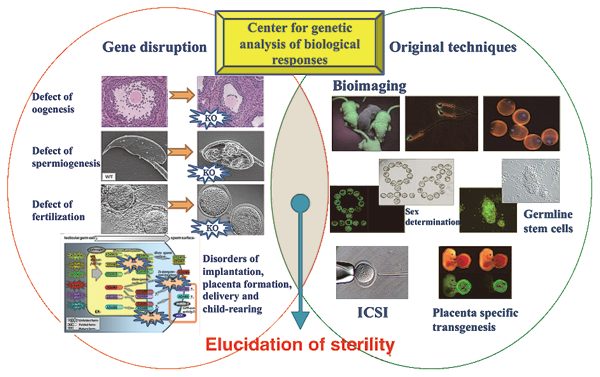Research Group
| <Production laboratory for genetically-manipulated animals> |
|
| Head, Professor | Masahito Ikawa |
| SA Assistant Professor | Jun Ueda |
| <Resource laboratory for genetically-manipulated animals> |
|
| Guest Professor | Kenichi Yamamura |
| SA Associate Professor(SUP) | Ayako Isotani |
| Assistant Professor(SUP) | Haruhiko Miyata |
| <Laboratory for promotion of collaborative research> |
|
| Guest Professor | Yoichiro Iwakura |
| Guest Professor | Nobuaki Yoshida |
| Assistant Professor(SUP) | Naohisa Goto |
| Assistant Professor(SUP) | Yuhkoh Satouh |
| <Laboratory for analysis of genetically-manipulated animals> |
|
| Professor(SUP) | Shizuo Akira |
| Professor(SUP) | Hisashi Arase |
| Professor(SUP) | Taroh Kinoshita |
| Professor(SUP) | Hitoshi Kikutani |
| Professor(SUP) | Hiroshi Nojima |
| Professor(SUP) | Nobuyuki Takakura |
| Professor(SUP) | Masato Okada |
| Assistant Professor(SUP) | Yoshitaka Fujihara |
Research Projects
Our bodies are kept homeostatically stable by functions of proteins produced from many genes. In other words, our health is basically maintained in accordance with the balance of our gene products. Many diseases can therefore be traced to a defect in, or malfunction of, various genes. In order to find and develop new drugs or new therapy, it is very important to identify the function of each gene in vivo. However, at present, we do not have enough information about the function of various genes to clarify their relationships to each other, or to analyze the relationships to specific diseases systematically.

Figure 1. Strategy for elucidating sterility
Gene-disrupted animals can be a powerful tool in helping us understand the role of certain genes in vivo. Such animals can be produced and used as a model for various human diseases as well as to screen new drugs. With this in mind, preparation of gene-disrupted mouse lines of entire genes is planned and progressing as research projects on a national level in many countries. The production of gene-manipulated animals may have another aspect. These animals are considered to be variable animal resources protected by patents to develop new drugs and therapeutic methods. It is highly important for Japan to make a reasonable contribution in this area. Under these circumstances, we created a consortium of three research institutes from three universities (The Research Institute for Microbial Diseases, Osaka University: The Institute of Medical Science, University of Tokyo: Center for Animal Resources and Development, Kumamoto University), placing the headquarters at Kumamoto University. With this consortium, we are sharing our specialties with each other and aiming to produce many gene-manipulated animals closely focused on human diseases. In our center, we are mainly focusing on genes related to reproduction, infection and allergy, taking advantage of an existing disease screening system in our university, including features such as fluorescent colored sperm and eggs (Figure 1). Through these gene-manipulated animals, we aim to perform translational research for the establishment of new therapeutic systems and to aid in the discovery of new drugs.
Major publications
- Mashiko D, Fujihara Y, Satouh Y, Miyata H, Isotani A, Ikawa M. Generation of mutant mice by pronuclear injection of circular plasmid expressing Cas9 and single guided RNA. Sci Rep. 2013 Nov 27;3:3355.
- Hasuwa H, Ueda J, Ikawa M, Okabe M. MiR-200b and miR-429 Function in Mouse Ovulation and Are Essential for Female Fertility. Science. 2013 Jul 5;341(6141):71-3.
- Fujihara Y, Tokuhiro K, Muro Y, Kondoh G, Araki Y, Ikawa M, Okabe M. Expression of TEX101, regulated by ACE, is essential for the production of fertile mouse spermatozoa. Proc Natl Acad Sci U S A. 2013 May 14;110(20):8111-6.
- Satouh Y, Inoue N, Ikawa M, Okabe M. Visualization of the moment of mouse sperm-egg fusion and dynamic localization of IZUMO1. J Cell Sci. 2012 Nov 1;125(Pt 21):4985-90.
- Tokuhiro K, Ikawa M, Benham AM, Okabe M. Testis specific PDILT is required for quality control of sperm membrane protein ADAM3 and male fertility. Proc Natl Acad Sci U S A. 2012 March 6;109 (10):3850-3855.
Links
- Laboratory HomePage